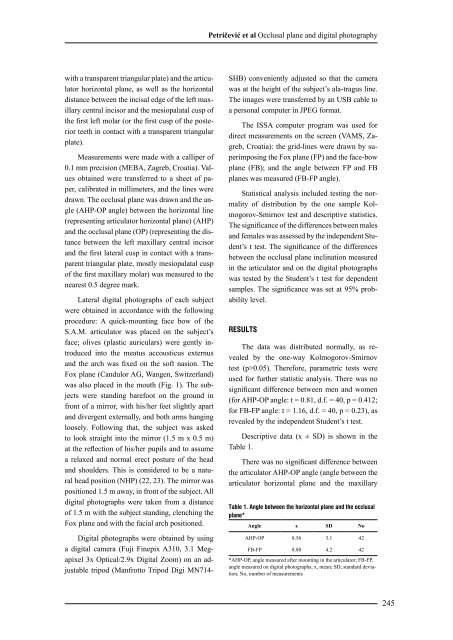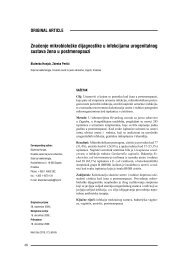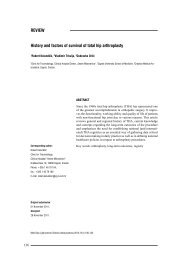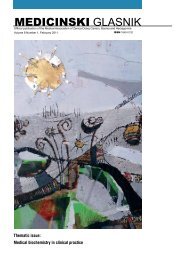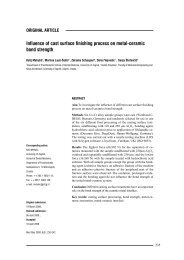MEDICINSKI GLASNIK
MEDICINSKI GLASNIK
MEDICINSKI GLASNIK
Create successful ePaper yourself
Turn your PDF publications into a flip-book with our unique Google optimized e-Paper software.
with a transparent triangular plate) and the articulator<br />
horizontal plane, as well as the horizontal<br />
distance between the incisal edge of the left maxillary<br />
central incisor and the mesiopalatal cusp of<br />
the first left molar (or the first cusp of the posterior<br />
teeth in contact with a transparent triangular<br />
plate).<br />
Measurements were made with a calliper of<br />
0.1 mm precision (MEBA, Zagreb, Croatia). Values<br />
obtained were transferred to a sheet of paper,<br />
calibrated in millimeters, and the lines were<br />
drawn. The occlusal plane was drawn and the angle<br />
(AHP-OP angle) between the horizontal line<br />
(representing articulator horizontal plane) (AHP)<br />
and the occlusal plane (OP) (representing the distance<br />
between the left maxillary central incisor<br />
and the first lateral cusp in contact with a transparent<br />
triangular plate, mostly mesiopalatal cusp<br />
of the first maxillary molar) was measured to the<br />
nearest 0.5 degree mark.<br />
Lateral digital photographs of each subject<br />
were obtained in accordance with the following<br />
procedure: A quick-mounting face bow of the<br />
S.A.M. articulator was placed on the subject’s<br />
face; olives (plastic auriculars) were gently introduced<br />
into the meatus accousticus externus<br />
and the arch was fixed on the soft nasion. The<br />
Fox plane (Candulor AG, Wangen, Switzerland)<br />
was also placed in the mouth (Fig. 1). The subjects<br />
were standing barefoot on the ground in<br />
front of a mirror, with his/her feet slightly apart<br />
and divergent externally, and both arms hanging<br />
loosely. Following that, the subject was asked<br />
to look straight into the mirror (1.5 m x 0.5 m)<br />
at the reflection of his/her pupils and to assume<br />
a relaxed and normal erect posture of the head<br />
and shoulders. This is considered to be a natural<br />
head position (NHP) (22, 23). The mirror was<br />
positioned 1.5 m away, in front of the subject. All<br />
digital photographs were taken from a distance<br />
of 1.5 m with the subject standing, clenching the<br />
Fox plane and with the facial arch positioned.<br />
Digital photographs were obtained by using<br />
a digital camera (Fuji Finepix A310, 3.1 Megapixel<br />
3x Optical/2.9x Digital Zoom) on an adjustable<br />
tripod (Manfrotto Tripod Digi MN714-<br />
Petričević et al Occlusal plane and digital photography<br />
SHB) conveniently adjusted so that the camera<br />
was at the height of the subject’s ala-tragus line.<br />
The images were transferred by an USB cable to<br />
a personal computer in JPEG format.<br />
The ISSA computer program was used for<br />
direct measurements on the screen (VAMS, Zagreb,<br />
Croatia): the grid-lines were drawn by superimposing<br />
the Fox plane (FP) and the face-bow<br />
plane (FB); and the angle between FP and FB<br />
planes was measured (FB-FP angle).<br />
Statistical analysis included testing the normality<br />
of distribution by the one sample Kolmogorov-Smirnov<br />
test and descriptive statistics.<br />
The significance of the differences between males<br />
and females was assessed by the independent Student’s<br />
t test. The significance of the differences<br />
between the occlusal plane inclination measured<br />
in the articulator and on the digital photographs<br />
was tested by the Student’s t test for dependent<br />
samples. The significance was set at 95% probability<br />
level.<br />
RESULTS<br />
The data was distributed normally, as revealed<br />
by the one-way Kolmogorov-Smirnov<br />
test (p>0.05). Therefore, parametric tests were<br />
used for further statistic analysis. There was no<br />
significant difference between men and women<br />
(for AHP-OP angle: t = 0.81, d.f. = 40, p = 0.412;<br />
for FB-FP angle: t = 1.16, d.f. = 40, p = 0.23), as<br />
revealed by the independent Student’s t test.<br />
Descriptive data (x ± SD) is shown in the<br />
Table 1.<br />
There was no significant difference between<br />
the articulator AHP-OP angle (angle between the<br />
articulator horizontal plane and the maxillary<br />
Table 1. Angle between the horizontal plane and the occlusal<br />
plane*<br />
Angle x SD No<br />
AHP-OP 8.56 3.1 42<br />
FB-FP 8.80 4.2 42<br />
*AHP-OP, angle measured after mounting in the articulator; FB-FP,<br />
angle measured on digital photographs; x, mean; SD, standard deviation;<br />
No, number of measurements<br />
245


